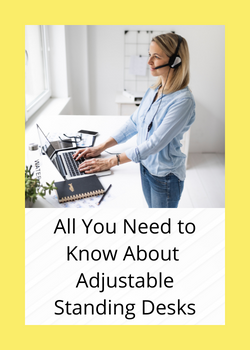 Adjustable standing desks allow you to raise and lower your workstation throughout the day.
Adjustable standing desks allow you to raise and lower your workstation throughout the day.
Alternating between sitting and standing is good for your health. It can also have a positive impact on your productivity, mood and motivation.
But with so much choice and new products coming onto the market all the time, it can be a tough task to find the right adjustable standing desk for you.
We’ve given you a run down below on the different types of desk, along with the pros and cons of each to help you to make the right choice…
The Semi-Adjustable Standing Desk
 You won’t find semi-adjustable desks labelled as such. They tend to come under the adjustable desk heading. But there are some significant differences to the fully adjustable standing desk which you should be aware of.
You won’t find semi-adjustable desks labelled as such. They tend to come under the adjustable desk heading. But there are some significant differences to the fully adjustable standing desk which you should be aware of.
When changing the height of a semi-adjustable desk, you will usually need to secure the legs in place with screws or locking pins. In most cases, the holes are drilled for you, meaning you’re limited to preset heights.
Semi-adjustable desks can be on the small side. Some come with wheels for easy portability and you’ll find a wide range of trolleys or carts which can provide a good short term or occasional option for standing whilst you work. (Again, you’ll often find these in the adjustable desk section when shopping around.)
Larger, more solid models are OK for occasional adjustment – for example if you need a desk to grow with your kid – but if you’re looking to alternate between sitting and standing at regular intervals throughout the day, you’d be better suited to a fully adjustable standing desk.
PROs – small models are better for compact workspaces, portability makes life easier if you’re working from home and need to swap rooms, these type of desks can grow with your children, saving you the expense of a new desk.
CONs – limited to preset heights, smaller cart or trolley type “desks” are usually less sturdy, semi-adjustable options aren’t suitable for regular height adjustment – not impossible but highly inconvenient.
The Fully Adjustable Standing Desk
Manual Adjustment
 Firstly, there’s the crank adjusting desk. As you would expect, these raise and lower by means of a crank handle.
Firstly, there’s the crank adjusting desk. As you would expect, these raise and lower by means of a crank handle.
This type of fully adjustable standing desk requires the most physical effort and takes the longest time for full adjustment. But if you’re on a tight budget and don’t mind taking the time and making the effort, this could be a good choice for you.
Just bear in mind that crank desks aren’t suitable for everyone. Certain musculoskeletal disorders (MSDs) can make height adjustment uncomfortable in the least, or downright impossible at the other end of the scale.
So if you suffer with carpal tunnel syndrome or arthritis for example, consider a different option which won’t aggravate your condition.
PROs – crank desks are a good budget-friendly option, minimise your carbon footprint with these non-electric workstations.
CONs – adjustment is slow and requires the most physical effort, not the best solution for everyone.
 Counterbalance standing desks also feature manual adjustment, but they are a lot quicker and smoother than their crank-handled cousins; full adjustment can take as little as 2 or 3 seconds with the assistance of a spring or gas cylinder.
Counterbalance standing desks also feature manual adjustment, but they are a lot quicker and smoother than their crank-handled cousins; full adjustment can take as little as 2 or 3 seconds with the assistance of a spring or gas cylinder.
Generally, these are more suitable for those with MSDs, but some models require a little effort for lowering.
With speed and grace comes a higher price tag. But again, these non-electric desks can be a better choice for the environmentally conscious.
PROs – fast and smooth adjustment, minimal effort required, another good non-electric option.
CONs – expect to pay more for a counterbalance desk, some require a little effort for lowering.
Electric Adjustment
 Electric desks usually feature single or dual motor operation. (L-shaped desks have three motors.)
Electric desks usually feature single or dual motor operation. (L-shaped desks have three motors.)
Some have a simple 2 button controller for up and down adjustment. Others allow you to program your favourite height settings.
Higher end models offer some neat extras such as sit stand reminders, anti-collision technology and auto-balance protection.
Of course, you’re going to get what you pay for and those extras will cost you more. But if you’re on a budget there are some really sound, lower end desks out there.
Check out our post on the Best Electric Desks Under £300
Some budget electric desks are poorly made and feature below par motors. Be sure to shop for well-known brands and check the motor / parts warranty. (Aim for a minimum of 3-year cover.)
PROs – wide range of controller options to suit your needs, minimal effort required for adjustment.
CONs – higher end models will set you back a few quid, you risk premature motor malfunction with “cheap” budget options.
Get the height right…visit Inch Calculator for recommended desk heights for seated and standing work.
The Adjustable Standing Desk Takeaway
Semi-adjustable standing desks have their place in this world – but not for those who are looking for regular workstation lowering and elevation.
If you want a desk that will allow you to alternate between sitting and standing throughout the day, opt for a fully adjustable standing desk.
If you want to keep your carbon footprint to a minimum, there are some great manual options available. Crank desks are best for budget, but won’t be the best solution if you suffer with certain MSDs. Counterbalance desks are fast and smooth, but expect to pay more for these models.
Top end electric desks can be super-smart and offer you a wide range of extras, so if you can afford it go ahead and spoil yourself. Mid and lower range electric desks may be lacking in all the extras, but there are still some great quality models out there.
Whichever type of desk you go for, do your homework, shop around and think about which features are most important to you. Remember to check out the warranty – especially for budget models – and make sure your new workstation is kind to your pocket, as well as good for your health.

